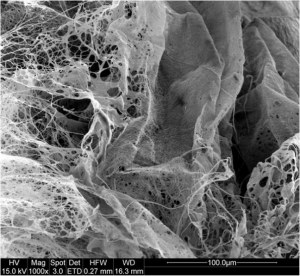Electrospun fibers are often used in the form of nonwoven membrane as most setups favor this form of output. Naturally, nonwoven electrospun membrane are most often tested for various applications. With advancement in the process, researchers have come out with various means of fabricating electrospun fibrous 3D bulk structures. Entanglements between fibers form large voids and high porosity within the bulk fibrous structure or foam. This gives it an extremely low density. Apart from use as an implantable scaffold, researchers are starting to investigate its properties for use in other applications.
A frequently investigated electrospun foam are manufactured using a process where long continuous electrospun fibers are chopped into short strand fibers followed by freeze drying to give a final bulk foam form. Chopping the fibers into shorter strands were found to be simple enough by cutting up the membrane into square pieces (1 cm x 1 cm) followed by homogenizing in a liquid media. This forms a slurry of short nanofibers suspension which can be freeze dried to a foam structure. The size of the macropores can be controlled by adjusting the freeze drying conditions. Other methods of producing freeze dried bulk fibrous structure involves using flowing water as collector [See
Thin layer 3D membrane and
Water Vortex]. Although these methods do not require the fibers to be chopped into shorter strands and homogenizing, they have not been sufficiently characterized in terms of its density and porosity.
The ultra-low density of freeze dried foam makes it comparable to aerogel. Si et al (2014) constructed a foam made of short strand electrospun fibers. A mixture of polyacrylonitrile/benzoxazine (PAN/BA-a) electrospun fibers and SiO
2 electrospun fibers were used to made into the foam. The lowest density obtained was 0.12 mg/cm
3 with porosity of 99.992%. The foam showed good thermal insulation property with prominent thermal conductivity of 0.026Wm
-1K
-1 which is close to that of air at ambient condition. Such good insulation property has been attributed to its high porosity. When the porosity reduces, the thermal conductivity increases.
As cellular foam, the electrospun fiber foam may also be used as sound absorption material. Sound absorption coefficient from electrospun PAN/BA-a and SiO
2 nanofibrous foam was found to be greater than 3M Thinsulate felt over frequency from 100-6300 Hz [Si et al 2014].
Electrospun foam was also found to be useful in water-in-oil emulsion separation. In electrospun membrane, surface water contact angle was found to increase if the material used is hydrophobic. Si et al (2014) showed that electrospun PAN/BA-a and SiO
2 nanofibrous foam demonstrated a high water contact angle and superoleophilicity. The foam readily allows oil to permeate through while water droplets were retained above. Similarly, Duan et al (2015) also showed that their electrospun methylacrylate copolymers foam was able to selectively absorb oil from water-in-oil mixture.
With the combination of macropores and micropores within the foam structure, it may also be used as a depth filter. Deuber et al (2016) used a combination of short nanofibers suspension and controlled freeze drying to construct a sponge comprising of macropores from the freeze drying and micropores from the distance between nanofibers. Their preliminary study showed that the filtration efficiency increased from 91% to 99.96% when the macropores were reduced from 122.6 µm to 15.2 µm. However, the most penetrating particle size (MPPS) remained from 134 to 202 nm across the sponges with different macropore sizes.
Published date: 20 December 2016
Last updated: -
▼ Reference
-
Deuber F, Mousavi S, Hofer M, Adlhart C. Tailoring Pore Structure of Ultralight Electrospun Sponges by Solid Templating. ChemistrySelect 2016 Article in press
-
Duan G, Jiang S, Jerome V, Wendorff J H, Fathi A, Uhm J, Altstadt V, Herling M, Breu J, Freitag R, Agarwal S, Greiner A. Ultralight, Soft Polymer Sponges by Self-Assembly of Short Electrospun Fibers in Colloidal Dispersions. Adv. Funct. Mater. 2015; 25: 2850.
-
Si Y, Yu J, Tang X, Ge J, Ding B. Ultralight nanofibre-assembled cellular aerogels with superelasticity and multifunctionality. Nature Communications 2014; 5: 5802.
Open Access
▲ Close list
 ElectrospinTech
ElectrospinTech
